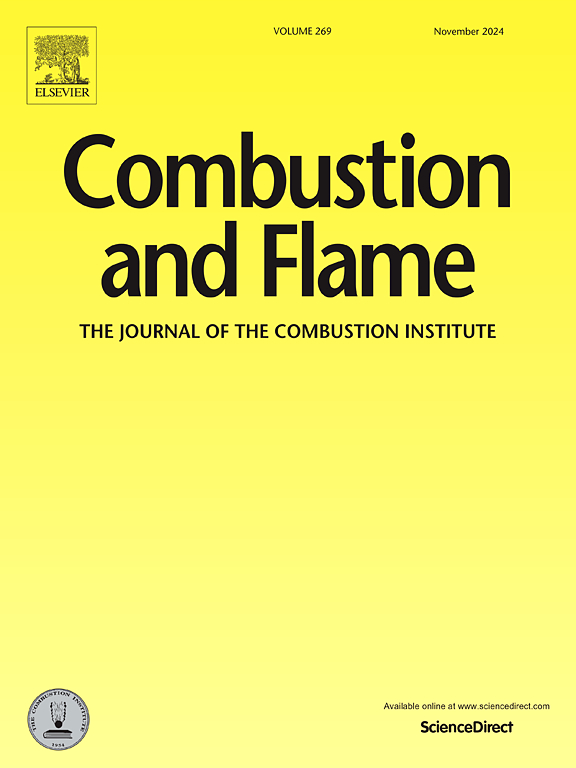A data-driven method to optimize soot kinetics based on uncertainty quantification and the active subspace approach
IF 5.8
2区 工程技术
Q2 ENERGY & FUELS
引用次数: 0
Abstract
This paper introduces a novel approach integrating uncertainty quantification (UQ) and data-driven techniques that aim to optimize soot particle size distributions (PSDs) using an existing soot kinetic model. Leveraging the active subspace (AS) method, the influential parameters governing the overall soot production and several representative PSDs are identified. Gradient descent techniques are employed to optimize the kinetic parameters simultaneously with reference to experimental measurements of burner stabilized stagnation (BSS) flames. The optimization process is rigorously validated against experimental data and the response surface predictions, demonstrating robustness and generalization capabilities across different cases. It is found that while the soot volume fraction was adequately predicted, the iterative UQ-assisted gradient descent technique can improve the prediction of PSDs but fails to fully reproduce the experimentally observed bimodality. This confirms the need for future improvements in the sectional kinetics model. In this regard, the analysis performed points at the need of distinguishing the coagulation kinetics of liquid-like and solid primary particles. With such future improvements, whose implementation is guided by the combined UQ and data-driven approach, soot modeling may advance into a data-driven era, minimizing reliance on expert knowledge alone.
基于不确定性量化和主动子空间方法的数据驱动烟尘动力学优化方法
本文介绍了一种整合不确定性量化(UQ)和数据驱动技术的新方法,旨在利用现有的烟尘动力学模型优化烟尘粒径分布(psd)。利用有源子空间(AS)方法,确定了控制总体烟尘产生的影响参数和几个具有代表性的psd。结合燃烧器稳定停滞(BSS)火焰的实验测量结果,采用梯度下降技术对动力学参数进行了优化。根据实验数据和响应面预测对优化过程进行了严格验证,证明了在不同情况下的鲁棒性和泛化能力。研究发现,在充分预测烟尘体积分数的同时,迭代uq辅助梯度下降技术可以改善psd的预测,但不能完全再现实验观察到的双峰。这证实了截面动力学模型需要进一步改进。在这方面,进行的分析指出需要区分液体和固体初级颗粒的混凝动力学。未来的改进将以UQ和数据驱动相结合的方法为指导,随着这些改进的实施,烟尘建模可能会进入数据驱动的时代,最大限度地减少对专家知识的依赖。
本文章由计算机程序翻译,如有差异,请以英文原文为准。
求助全文
约1分钟内获得全文
求助全文
来源期刊

Combustion and Flame
工程技术-工程:化工
CiteScore
9.50
自引率
20.50%
发文量
631
审稿时长
3.8 months
期刊介绍:
The mission of the journal is to publish high quality work from experimental, theoretical, and computational investigations on the fundamentals of combustion phenomena and closely allied matters. While submissions in all pertinent areas are welcomed, past and recent focus of the journal has been on:
Development and validation of reaction kinetics, reduction of reaction mechanisms and modeling of combustion systems, including:
Conventional, alternative and surrogate fuels;
Pollutants;
Particulate and aerosol formation and abatement;
Heterogeneous processes.
Experimental, theoretical, and computational studies of laminar and turbulent combustion phenomena, including:
Premixed and non-premixed flames;
Ignition and extinction phenomena;
Flame propagation;
Flame structure;
Instabilities and swirl;
Flame spread;
Multi-phase reactants.
Advances in diagnostic and computational methods in combustion, including:
Measurement and simulation of scalar and vector properties;
Novel techniques;
State-of-the art applications.
Fundamental investigations of combustion technologies and systems, including:
Internal combustion engines;
Gas turbines;
Small- and large-scale stationary combustion and power generation;
Catalytic combustion;
Combustion synthesis;
Combustion under extreme conditions;
New concepts.
 求助内容:
求助内容: 应助结果提醒方式:
应助结果提醒方式:


